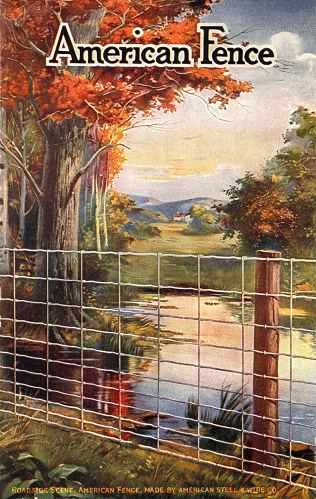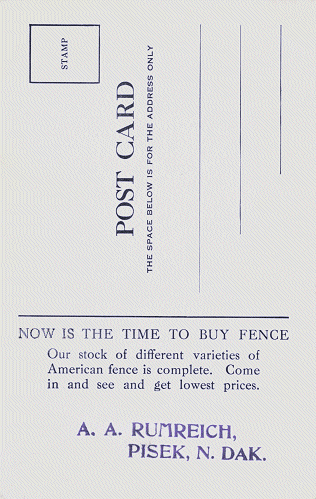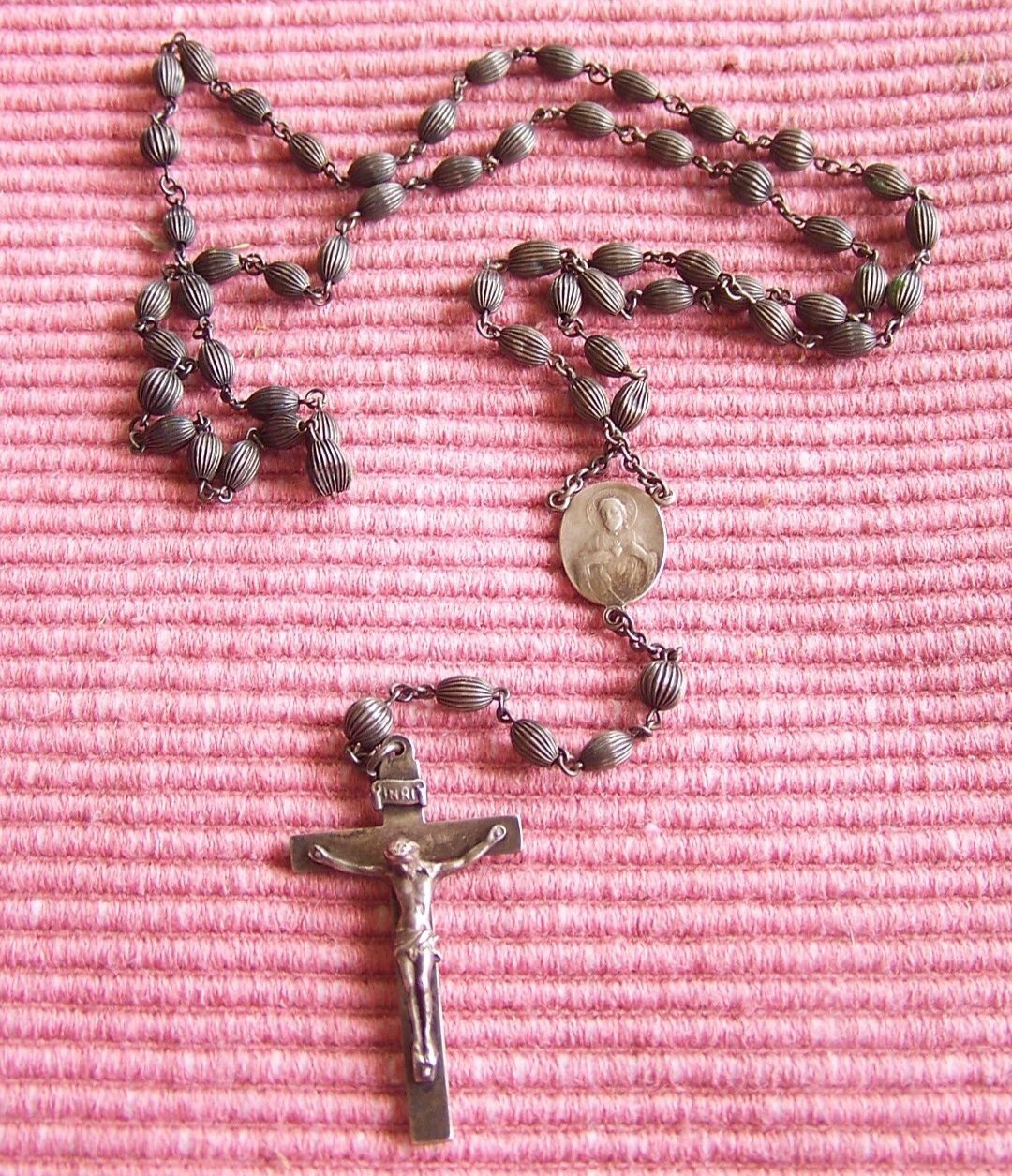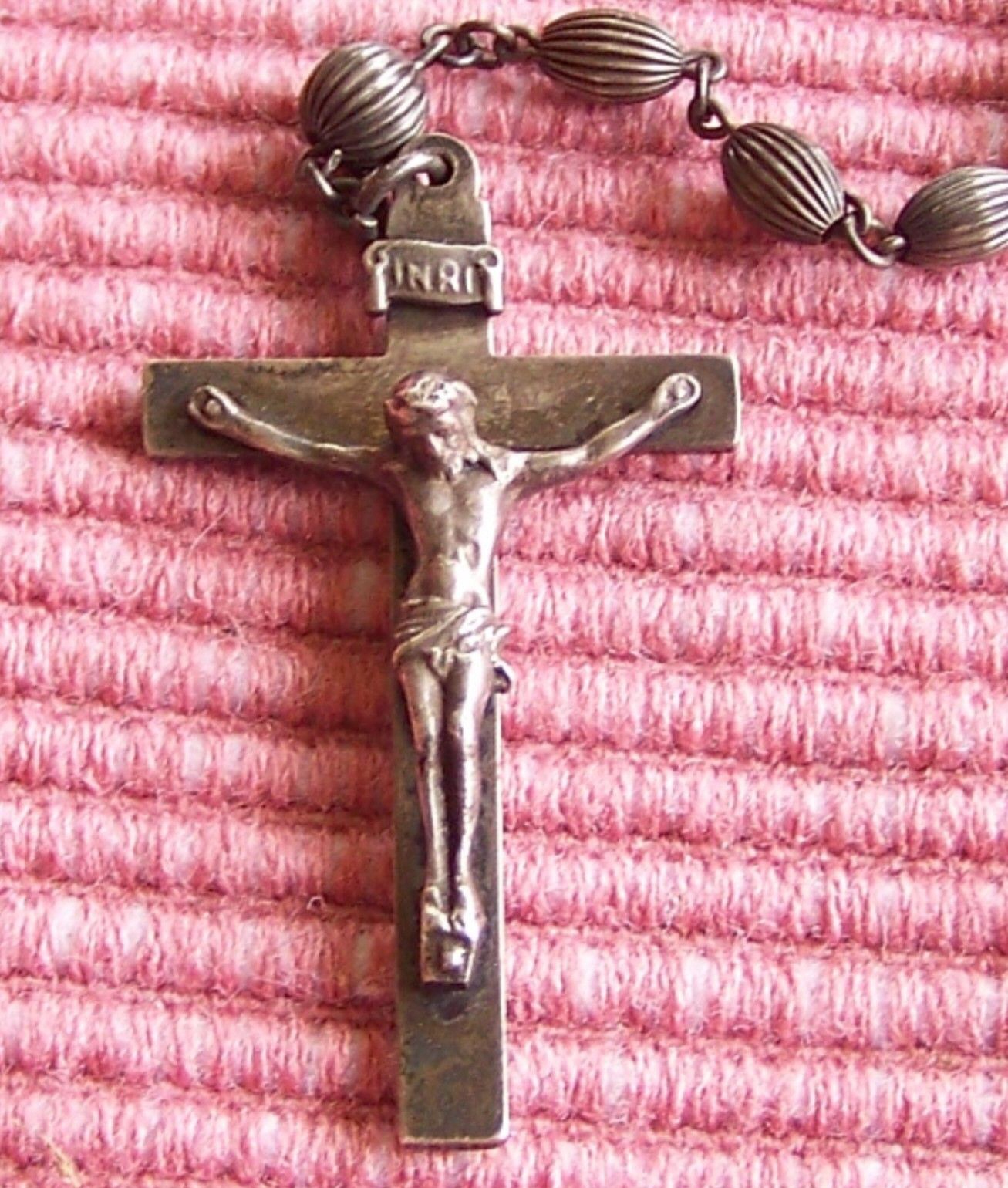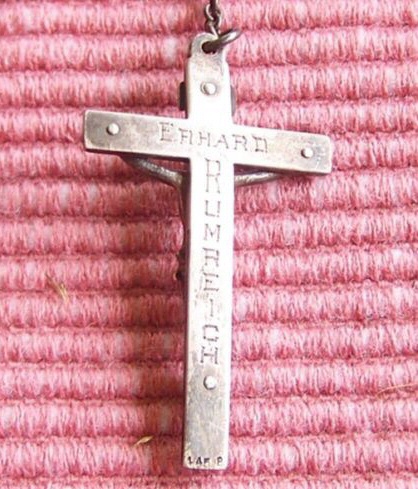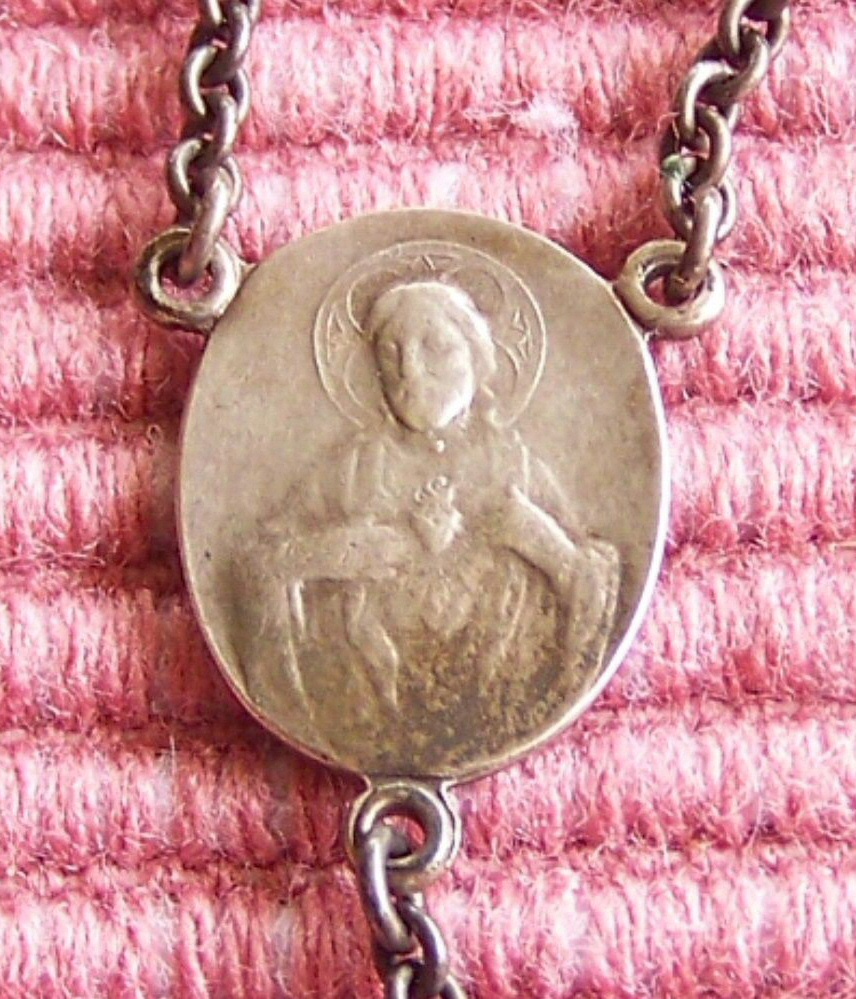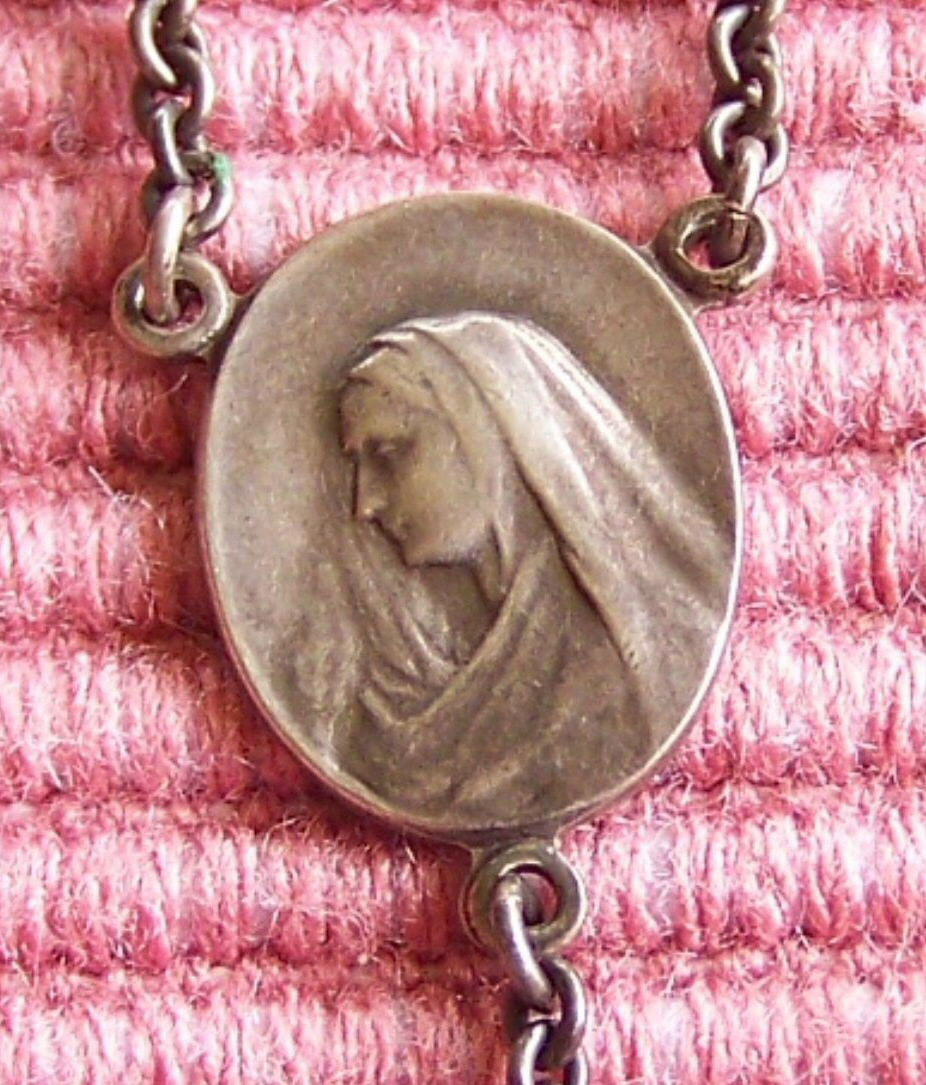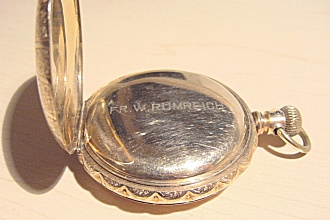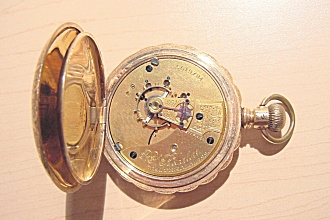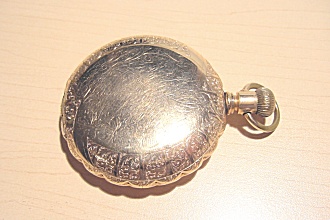John K. Rumreich Brush Holder
John K. Rumreich moved to Mahnomen in 1909 and operated a farm implement and hardware business there.
Ads for his business frequented the Mahnomen Pioneer newspaper from the teens through the forties.
This aluminum whisk broom holder would likely have been given away as a promotional item to loyal customers.
It reads: This Will Hold Your Brush. Our Service and Quality Will Hold Your Trade.
John K. also served as Mahnomen's mayor in 1915 and 1916.
|
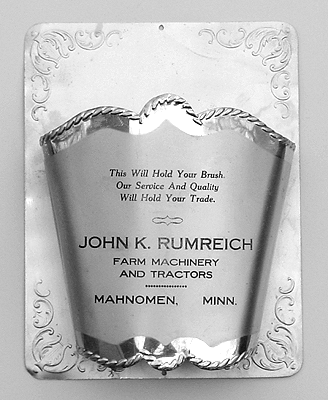
|
|
A. A. Rumreich American Fence Advertising Postcard
Albert A. Rumreich ran the town hardware store in Pisek, North Dakota in the early part of the last century.
This advertising postcard from the store proclaims "Now is the time to buy fence -
Our stock of different varieties of American fence is complete. Come in and see and get lowest prices."
American Fence was made by the American Steel & Wire Company, a subsidiary of United States Steel.
Their steel mill in west Duluth, Minnesota supplied the prairies with fencing, fence posts, nails and rebar.
The plant was capable of making 200,000 miles of barbed wire and 23,000 miles of woven wire fencing per year.
The nails, of some 300 different kinds, filled 650,000 kegs (100 pounds each) on a yearly basis.
|
A. A. Rumreich Hardware Advertising Calendar
This is a 1905 advertising calendar from the A. A. Rumreich Hardware Store.
It reads: "Compliments of A. A. RUMREICH Proprietor of the lowest price and best qualities HARDWARE, PISEK, N.D."
This ornate diecut calendar pictures two Victorian girls with their dolls.
It measures 10" x 13.25".
The calendar pad at the bottom begins with the month of March, and has a label attached that reads: "For Precinct Committeeman Wm. Nickolay."
Courtesy of Doug Hudson.
|

|
|
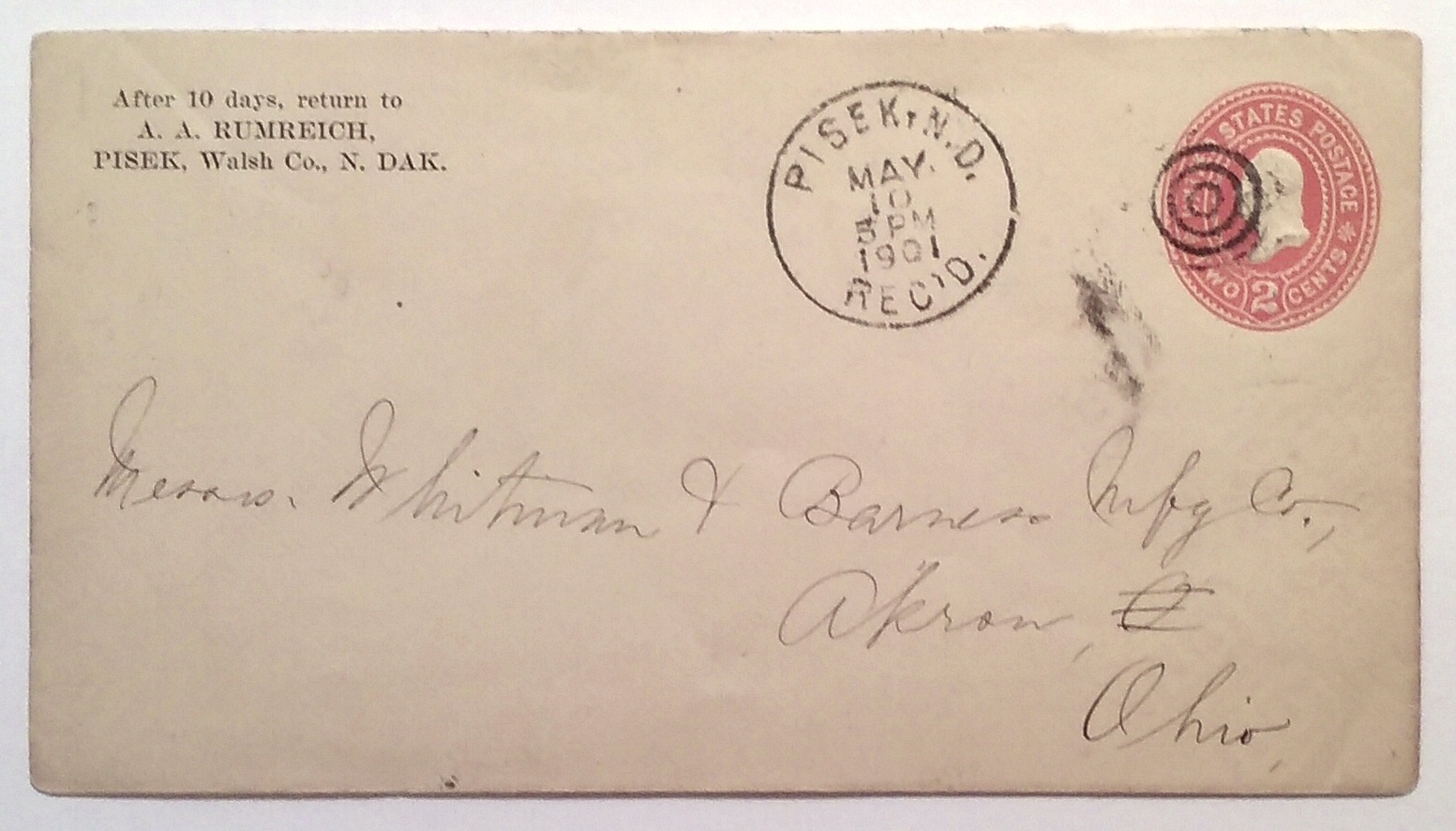
|
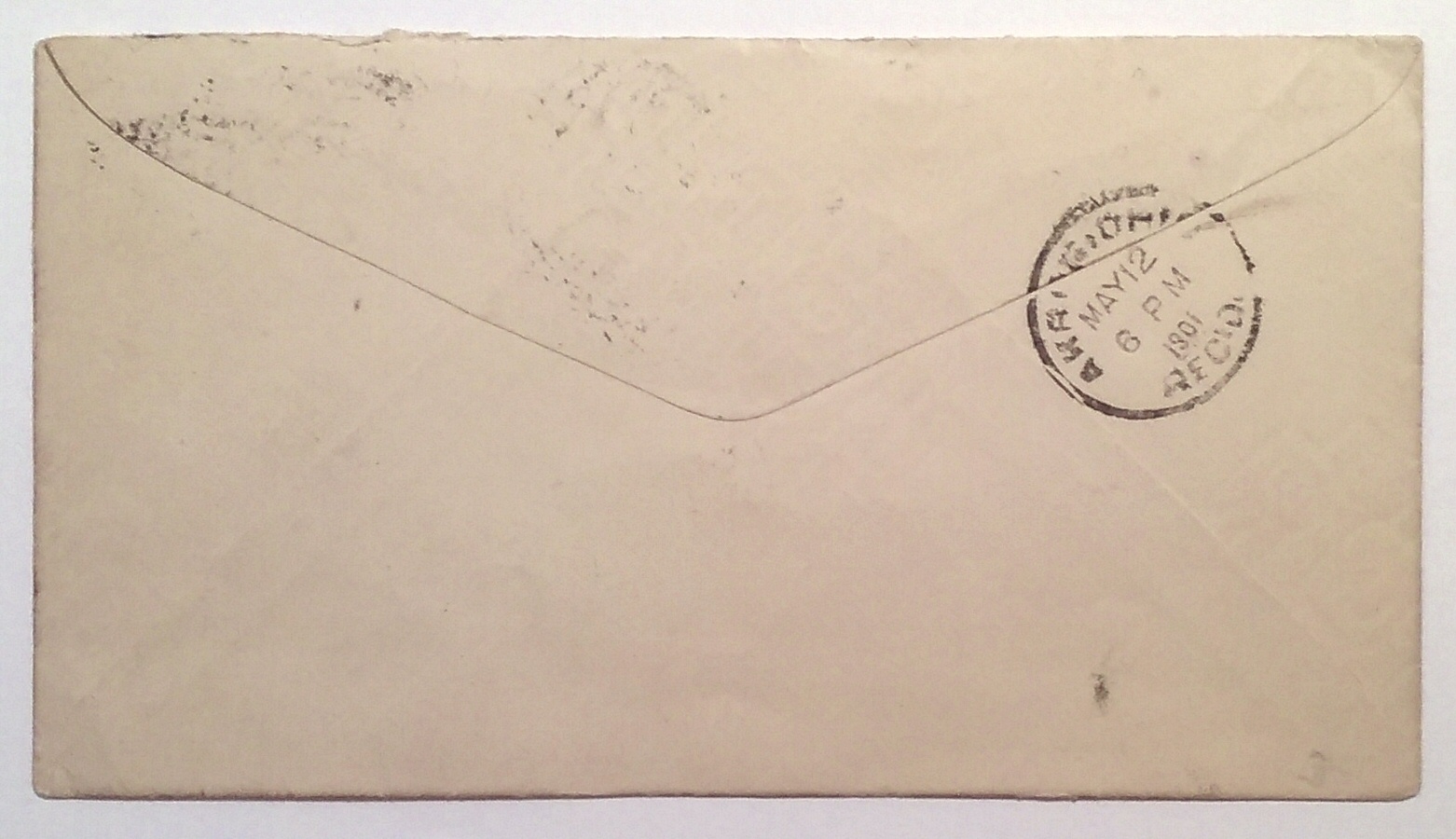
|
A. A. Rumreich Envelope
This envelope was used for correspondence from A. A. Rumreich to the Whitman & Barnes Manufacturing Company of Akron Ohio.
Whitman & Barnes were manufacturers of mowing and reaping machine knives, sickles, sections and parts of cutting apparatus, Diamond twist drills, reamers and collateral lines, wood handle and drop forged wrenches, lawn mowers, haying tools, such as hay carriers, forks, pulleys, etc., spring keys and cotters. rubber pad horse-shoes, hammers, planer knives and cutters for wood-working machinery.
|
|
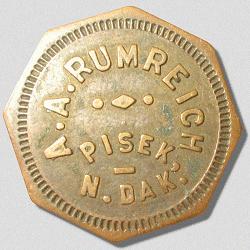
|
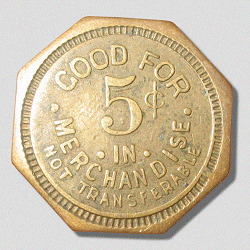
| | obverse | reverse |
5 cent A.A. Rumreich token, 1 inch diameter
A. A. Rumreich 5 Cent Trade Token
In the early part of the last century, trade tokens were used by the owners and operators of general mercantile stores, as well
as proprietors of groceries, bakeries, dry goods stores, and other retail establishments and service facilities. These proprietors were
a thrifty people. They found in the token a device that gave them a competitive edge over rival merchants, and they made the most of
it. Some used the small-denomination tokens as handouts to stimulate trade and bring customers into their stores; others purchased
farm produce of many kinds for resale and paid more in trade than in cash, always in tokens, to assure that the trading took place at
the proper location; while still others used tokens as a bookkeeping tool, advancing a sum in tokens to be repaid when the customer
brought in produce, thus avoiding the necessity of itemizing credit purchases every time the buyer came to the store.
This brass token was issued by the A. A. Rumreich Hardware store for one or more of these purposes.
Courtesy of Judy Rumreich.
|
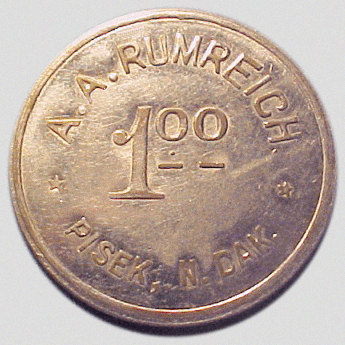
|
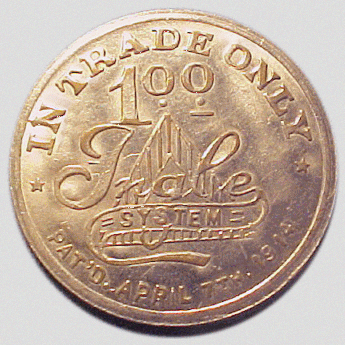
| | obverse | reverse |
A.A. Rumreich Ingle System token, 1 3/8 inch diameter
A. A. Rumreich Ingle System Trade Token
Counterfeiting of store tokens was quite prolific until the early part of the 20th century.
Until that time, all that was required for a counterfeiter to reproduce a token was the mere act of obtaining it.
Once obtained, a counterfeiter could send the token to a litany of manufacturers and request to have it reproduced en-masse.
Because token manufacturers of the era did not cooperate with one another to verify the legitimacy of such requests,
all the counterfeiter had to do was ensure they did not send the request to the original manufacturer.
As a means to combat this problem, David E., Edwin H., and Wesley Ingle devised a strategy of patenting token "designs."
Once patented, they could stamp their patent number along with their design on all of the tokens they struck.
This simple method virtually guaranteed that the tokens they produced would not be counterfeited.
If and when a token manufacturer was asked to duplicate an Ingle token, the manufacturer would refuse out of fear of violating U.S. patent laws.
Using this new strategy, the Ingle brothers opened a token-manufacturing business in 1909.
Their method became known as the "Ingle System," and the family business became highly successful.
See the April 7, 1914 Ingle System patent
here.
|
Painting of Saints Cyril and Methodious
The painting of Saints Cyril and Methodious by Alfons Mucha is an important part of Rumreich family history.
This mural-sized work was commissioned by Frank Paul Rumreich in 1885 and still graces St. John's Church in Pisek.
Frank Paul Rumreich was one of the first settlers to arrive from Europe to start the town of Pisek, North Dakota.
He made trips to visit his homeland many times, always returning with friends and relatives to settle around Pisek.
While there one time, he commissioned the now famous artist, Alfons Mucha, to paint a picture of Saints Cyril and Methodius -
the patron saints of Moravia. Their names were hoped to be used in the naming of the new Catholic church in Pisek.
The painting was brought to Pisek in 1887 by Frank's sister Marie, when she and her family sailed to the U.S.
Ultimately, the church was named St. John Nepomucene, but the magnificent 6' x 10' painting of Saints Cyril and Methodius
still hangs in the church.
Click here for more information.
|

|
|
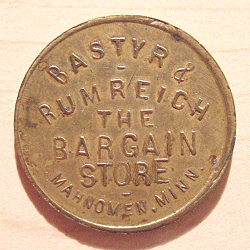
|
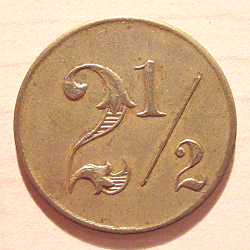
| | obverse | reverse |
2 1/2 cent Bastyr & Rumreich token, 1 inch diameter
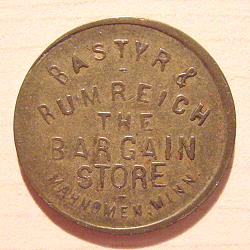
|
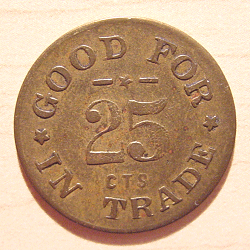
| | obverse | reverse |
25 cent Bastyr & Rumreich token, 1 inch diameter
Bastyr & Rumreich Trade Tokens
In 1915, Frank W. Rumreich moved to Mahnomen, Minnesota from Montana.
He opened a grocery store with a partner, Frank A. Bastyr. Bastyr had come to Mahnomen with his parents in 1911.
The store opened on May 8th, 1915, in a building owned by John K. Rumreich. It was called The Bargain Store.
As was typical of many general stores of this era, especially in the Midwest, merchants issued tokens to pay farmers
for their produce in order to save bookkeeping and to provide change in remote rural areas far from banks.
Farm workers tokens - pickers and peelers checks - blossomed during this period.
These brass tokens are examples of those issued by the Bastyr & Rumreich store for this purpose.
Click here for more information.
|

|
Doc Rumreich Medicine Bottle
This medicine bottle from the Mahnomen Drug Company bears Doc Rumreich's name and reads "Use as an eye-wash frequently."
It's dated 9-10-26.
It would likely have been a boric acid solution, a formula still used for eye washes today.
This was essentially over the counter in as much as you didn't need a prescription.
It probably would not have been pre-bottled and would have been mixed by the druggist.
The bottle is 5 inches tall.
Click here for more about Doc.
Click here for more information about Doc and the Rumreichs of Mahnomen.
|
|
Doc Rumreich Rosary
This is the rosary of Erhard "Doc" Rumreich.
He was a member of St. Michael's Catholic Church and served as Grand Knight of the Knights of Columbus from 1925 to 1927.
Click here for more about Doc.
Click here for more information about Doc and the Rumreichs of Mahnomen.
|
Frank W. Rumreich Pocket Watch
This is the pocket watch of Frank W. Rumreich (1876 - 1922).
The movement was manufactured by the American Waltham Watch Company and is model 1883, "P.S. Bartlett" grade.
It's an 18 size, lever-set movement in a gold-filled hunter case.
Based on the serial number, the watch was manufactured between November 1892 and February 1893 - Frank would have been 16 at the time.
The American Waltham Watch Company, also commonly referred to as the "Waltham Watch Company,"
is without a doubt the most important American watch company.
Formed in 1852, it was the first company to truly mass produce watches here in the U.S.
The history of the company is a little complicated, but it all started in 1850 when Edward Howard, David Davis
and Aaron Dennison got together in Roxbury, Massachusetts, and decided to start their own watch company.
They formed the "American Horologue Company" in 1851 and 17 prototype watches were produced in 1852 with "Howard, Davis & Dennison" engraved on the movements.
The name of the company was then changed to the "Warren Mfg. Co." and the next 26 or so watches produced bore the name "Warren" on their movements.
The name was officially changed to the "Boston Watch Company" in 1853, and in 1854 a factory was built in Waltham, Massachusetts.
The founders of the company certainly knew how to make great watches, but weren't so hot at managing money, and the Boston Watch Company failed in 1857.
The story doesn't end there, though!
The defunct company was sold at a sheriff's auction to a man named Royal Robbins, and he reorganized the company
and renamed it the "Appleton, Tracy & Co." In 1859 the Appleton, Tracy & Co. merged with another company called the Waltham Improvement Company, and "The American Watch Company" was born.
Soon after that, the company name was changed to "The American Waltham Watch Company," and in later years the watches simply bore the name "Waltham".
Over 35 million Waltham watches were produced during the company's long history, and many of them still exist today.
Although they made many low and medium grade watches to suit the needs of the existing markets,
Waltham also produced watches of exceedingly high quality.
They also probably produced more types of watches than any other American company, including railroad watches, chronographs, repeating watches and deck watches.
Early Waltham watches with low serial numbers are especially prized by many collectors.
|
Adolph S. Rumreich Public Health Report
Dr. Adolph S. Rumreich worked for the US Public Health Service investigating the methods of transmission of Rickettsial Diseases
such as Rocky Mountain spotted fever and Murine (Endemic) Typhus.
He published numerous papers on the subject, with his associates, Doctors Rolla E. Dyer and Lucius F. Badger.
This report, published in 1931, demonstrated that the virus of the eastern type of Rocky Mountain spotted fever is preserved in the
body of the American dog tick (Dermacentor Variabilis) through at least one moult.
|
From the February 21, 1931 issue of Science News magazine:
FLEAS CAN PROBABLY TRANSMIT TYPHUS FEVER, SCIENTISTS SAY
For the first time, the flea has been definitely incriminated as a probable vector in the transmission of typhus fever in this country.
Experiments indicating this have just been reported by Drs. R.E. Dyer, A.S. Rumreich, and L.F. Badger of the U.S. Public Health Service.
Typhus fever in the Old World seems to be of slightly different type from the disease in the New World, and is transmitted by
the body louse. It has been called jail fever and ship fever and was very prevalent in jails, crowded barracks and ships, city slums,
and wherever people lived in congestion and filth. The disease has never reached serious epidemic proportions in the United States,
and for many years very few cases have been reported.
The fact that the disease occurred in people who were not infested with lice led American investigators to suspect that some other
insect was transmitting typhus fever in this country.
|
|
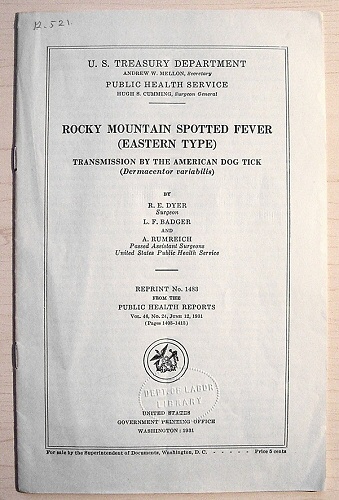 Click here to see the full-size image.
Click here to see the first page of the report.
Click here to see the full-size image.
Click here to see the first page of the report.
|
|
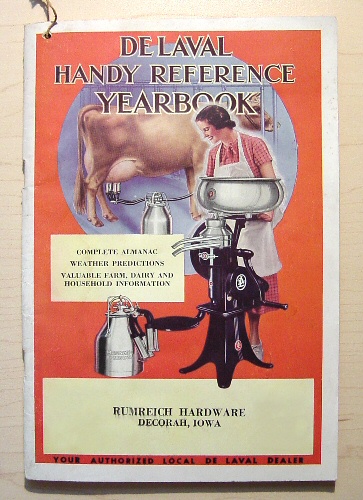
|
1941 De Laval Handy Reference Yearbook from Rumreich Hardware, Decorah, IA
In 1940, Rudolph Rumreich moved to Decorah, IA, where he opened Rumreich Hardware in the building at 106 East Water Street.
He had previously owned a hardware store in Adams, MN.
Here's an article about him and the store from the 1946 Hardware Age magazine.
This yearbook would have been given away as a promotional item to customers.
It contains weather predictions, farm, dairy and household information and, of course, abundant De Laval product information.
It measures 5" x 8".
In 1950, Rudolph and his family moved to Grand Forks, ND, where he owned rental units and was city assessor.
The hardware store was subsequently purchased and operated by Tony Bowlus.
|
|
Memorial to Ivancice emigrants
This memorial is dedicated to the emigrants who left Ivancice and moved to Pisek in the States.
It was commissioned by Frank Paul Rumreich in 1908.
The memorial is along a former road from Nemcice to Budkovic.
The road no longer exists and the cross-memorial is in the middle of a field,and in poor condition.
The photo is from 2008.
Courtesy of J. Vecera, Head of the Ivancice Museum.
|

|
|
 Rumreich Museum
Rumreich Museum

